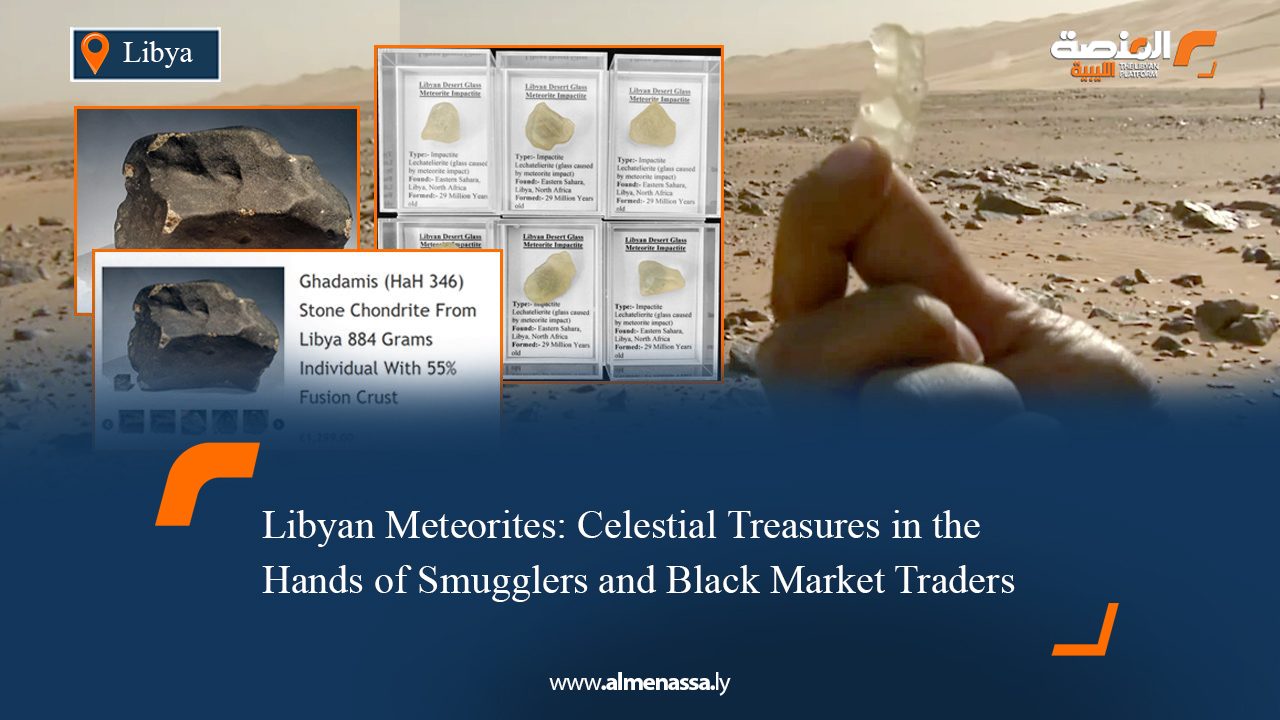Meteorite trading has surged across North Africa, particularly in the desert corridor between Libya and Niger — one of the world’s richest zones for rare extraterrestrial stones. In Libya, Dar al-Ghani field stands out as a globally significant site.
Located on a limestone plateau in the Libyan desert, Dar al-Ghani stretches roughly 200 kilometers in length and up to 60 kilometers in width. Its dry climate and unique geology — composed of clay, dolomite, and limestone, with minimal silica erosion — make it ideal for preserving meteorites.
By July 2001, 869 meteorites had been recovered from the site, weighing a total of 687 kilograms. The largest specimen tipped the scales at 95 kilograms. Though not listed in Libya’s national atlas, the International Meteorite Naming Committee officially recognized the name, which now appears on geological maps as part of the Sarir al-Qatusa plateau.


Near Libya’s border in Niger, the largest known Martian meteorite — NWA 16788 — was discovered in 2023. Weighing 22 kilograms, it was sold last month at a New York auction for over $5 million. The sale sparked controversy, prompting Nigerien authorities to launch an investigation into alleged illegal international trade. All exports of gemstones and meteorites were suspended to ensure traceability, while Sotheby’s insisted the transaction followed international protocols.
Under UNESCO regulations, meteorites are considered part of cultural heritage. However, Niger must prove ownership to reclaim the specimen. The case reignited debate over fair legal frameworks for trading rare space rocks, especially in border regions rife with informal collection and smuggling.


Libya’s Black Market: A Hidden Economy of Celestial Stones
Almenassa’s investigative team contacted traders in Libya’s black market for meteorites and gemstones. One dealer, speaking anonymously, described a thriving illicit trade funneling meteorites abroad.
He listed several types commonly trafficked: Irons, Lunars, Martians, Chondrites, Eucrites, and Pallasites — each with distinct value on the global market.
The trader also highlighted Libyan Desert Glass — a rare yellow-green natural glass believed to have formed from a meteorite impact some 28 million years ago. Found only in two known locations worldwide — Egypt’s Great Sand Sea and Jabal al-‘Uwaynat near the Libya-Sudan border — the glass is prized for its metaphysical properties and use in jewelry.


Its unique bubble-rich texture and high silica content, with traces of aluminum, iron, titanium, nickel, and cobalt, make it highly sought after. Historically, it has been traded across cultures and used in ornamental crafts.
Almenassa documented several Facebook pages and listings on Open Libya Market used for black-market meteorite sales. Prices are often set through public bidding. One listing offered a 21-kilogram Chondrite meteorite starting at $260, while another advertised a 1,200-kilogram shipment in Benghazi with an opening price of 2,500 Libyan dinars. Most sellers preferred anonymity and conducted transactions via private messages.
A notable recent example is Hamada al-Hamra 346 (HaH 346), reportedly seen falling as a fireball over Jabal al-Gharbi in August 2018. Months later, hundreds of fragments totaling over 100 kilograms were collected near Shuwairif.


The stones featured a fresh, matte-black fusion crust, indicating a recent fall with minimal erosion. Marketed under the name “Ghadames,” the meteorite was sold in bulk to international dealers.
Petrographic and geochemical analysis classified it as an ordinary L6 chondrite with high shock (S5) and no weathering (W0), enhancing its scientific value. Its composition includes olivine, low-calcium pyroxene, plagioclase, chromite, troilite, and iron-nickel alloys. Samples were sent for study to the Museum für Naturkunde in Berlin (MNB) and Arizona State University (ASU).
Experts caution that Libya’s lack of clear legislation leaves these natural assets vulnerable to exploitation. Without protective frameworks, the country risks losing both the scientific and economic benefits of its meteorite wealth — especially amid rising global demand for rare space rocks and Libyan Desert Glass


